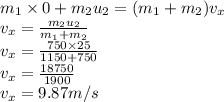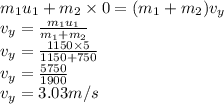
Physics, 12.10.2019 15:30 PinkDivaGirl02
Two cars collide at an icy intersection and stick together afterward. the first car has a mass of 1150 kg and was approaching at 5.00 m/s due south. the second car has a mass of 750 kg and was approaching at 25.0 m/s due west.
calculate the final velocity of the cars. (note that since both cars have an initial velocity, you cannot use equations 7.6a and b. you must look for other simplifying aspects.)
magnitude (answer in m/s
direction ° (counterclockwise from west is positive)
(b) how much kinetic energy is lost in the collision? (this energy goes into deformation of the cars.)

Answers: 2
Another question on Physics


Physics, 22.06.2019 14:30
What is the relationship between the direction of motion of the balloon and the wind currents
Answers: 1

Physics, 23.06.2019 01:30
When a lead acid car battery is recharged by the alternator, it acts essentially as an electrolytic cell in which solid lead(ii) sulfate is reduced to lead at the cathode and oxidized to solid lead(ii) oxide at the anode. suppose a current of is fed into a car battery for seconds. calculate the mass of lead deposited on the cathode of the battery.
Answers: 3

Physics, 23.06.2019 04:31
Elements in group viiia (also known as group 18, or the noble gases) have similar properties because they all have a. the same number of electron shells b. full octets c. the same number of valence electrons d. the same number of electrons needed to fill their octet
Answers: 1
You know the right answer?
Two cars collide at an icy intersection and stick together afterward. the first car has a mass of 11...
Questions

Mathematics, 05.12.2020 23:00





English, 05.12.2020 23:00

Mathematics, 05.12.2020 23:00


Mathematics, 05.12.2020 23:00

Mathematics, 05.12.2020 23:00









English, 05.12.2020 23:10

 = 1150 kg
= 1150 kg =750 kg
=750 kg = 5.00 m/s in y axis
= 5.00 m/s in y axis = 25.0 m/s in x axis
= 25.0 m/s in x axis



![\Delta E = [\frac{1}{2}m_{1}u_{1}^2 +\frac{1}{2}m_{2}u_{2}^2 ] - \frac{1}{2}(m_{1}+m_{2})v^2\\\Delta E = [\frac{1}{2}\times1150\times5}^2 +\frac{1}{2}\times750 \times 25^2 ] - \frac{1}{2}(1150+750})10.3^2\\\Delta E = 147,964.5 J](/tpl/images/0313/4415/10665.png)


